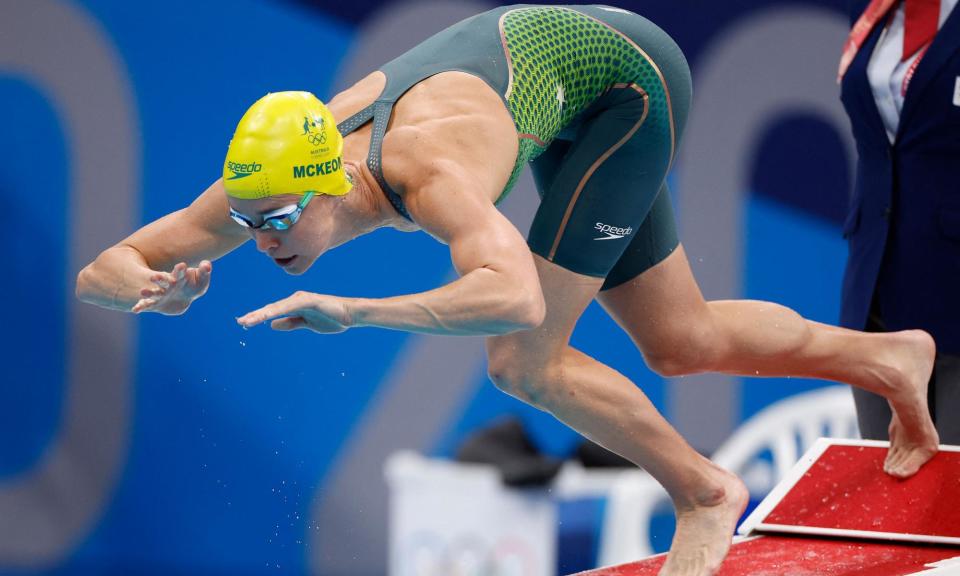Olympic dreams in 3D: Australian swimmers turn to VR goggles in pursuit of Paris gold

Australia’s Olympic swimmers are stepping into the realm of virtual reality to maximise their performances at the Paris Games in July. The relay team have started using virtual reality goggles as a new tool to improve their changeover times by the fractions of a second that can decide gold and silver medals.
The Australian team was on the podium in all seven swimming relay events at the Tokyo Games, including gold in the women’s 4x100m freestyle and medley relays, as part of a record medal haul. But ambitions are even higher for Paris, after Australia won three gold medals, three silver and one bronze in the same seven events at last year’s world championships in Fukuoka.
Related: Will Yang: the Olympic swim hopeful bridging the gap between Australia and China | Nicole Jeffery
Fast relay changeovers, in the range of 0.1 to 0.2 of a second, can make a difference of between half a second and a second to the total time of the team.
The Australian team held a relay camp immediately after last month’s national championships on the Gold Coast where the swimmers were introduced to VR goggles which have been programmed with 3D video of their teammates swimming into the finish of a relay leg. This allows them to watch how each swimmer finishes their leg and judge exactly when they should leave the blocks to make a fast, but legal changeover.
Teams are disqualified if the electronic timing registers that a swimmer’s feet have left the blocks before the previous swimmer has touched the wall.
Swimming Australia’s general manager for performance support Jess Corones said the team support staff were exploring new technology to optimise the speed of the changeovers.
“What we’re trying to do is find different creative ways of getting relay athletes to be able to practice that changeover,” Corones said. “You’ve got the physical practice, obviously, but then there’s the anticipation of the swimmer coming into the wall. Often when you’re on the national team, you’re not changing over with someone in your [training] squad, so they have quite limited time to actually practice the changeovers.”
Corones said the VR goggles allowed the swimmers to visualise changeovers more effectively and practice more regularly.
“The last couple of years leading into Tokyo, we would just video [all the relay swimmers] and they would have a standard video on their phones, and they could go through and watch it,” she said. “It helps them with their anticipation, making sure they’ve got good awareness and making them as comfortable as they can be in that environment to execute the skill at a really high level. The VR goggles are taking that to another level where we’re trying to create an even more real environment.”
The team’s sport scientists have spent the last few months filming each potential relay swimmer from above the starting blocks to capture the view that a swimmer standing on the starting blocks has of the swimmer finishing their leg of a relay. The film is then uploaded to the goggles.
“The next phase [post-Paris] will be seeing if we can bring their movement pattern into that,” Corones said. “At the moment it’s about visualisation and anticipating timing and the preparation that they need mentally for that. They can’t dive in [with the VR goggles] but we might be able to get them to do a standing jump so we could time their reaction.”
Australian head coach Rohan Taylor said the ability to simulate changeovers more effectively was a useful development. He said the coaches had also used “gamification” as part of their physical relay practice at the recent training camp.
“What we’re trying to do is put them under pressure, and measure them on changeovers,” Taylor said. “In between the relay legs, they’re having to do some sort of gamified tasks, like they have to shoot baskets. They got points for however many baskets they made before they got on the blocks. Then when they got on the blocks they had to execute the changeover within a time span to get maximum points.”
The goal is to teach the swimmers to execute their skills despite any external distractions, which is what they will face in the febrile environment of the Olympic arena. Corones added that the ultimate aim of performance analysis was to give athletes and coaches immediate feedback, in training and competition.
Biomechanist Dr Bruce Mason pioneered race analysis – measuring starts, turns and parts of a race to provide feedback to coaches and swimmers – at the Australian Institute of Sport in the 1990s. But the data delivery took some hours after each race, and was focused only on the Australian swimmers.
By the Tokyo Olympics in 2021, the national team’s performance analysts could produce the same data for all eight swimmers in a race in just over 20 minutes. And Corones said they would be 10% faster again in Paris.
“For the coaches there will be a noticeable increase in the speed in which they get their data,’’ she said. In a sport which is decided by hundredths of a second, that could make a difference.

 Yahoo Sport
Yahoo Sport 



































































